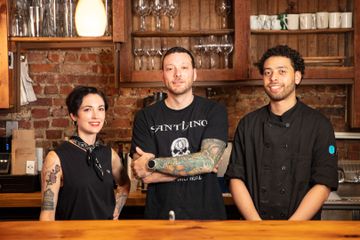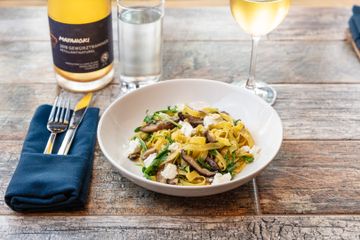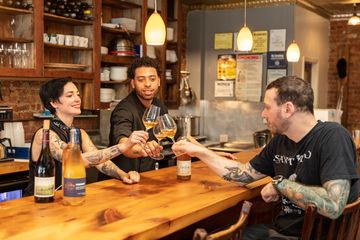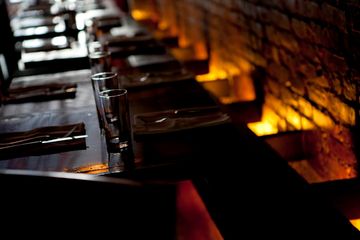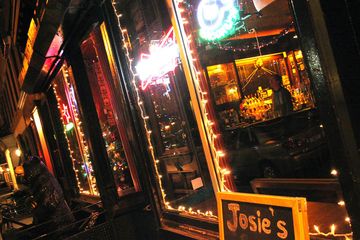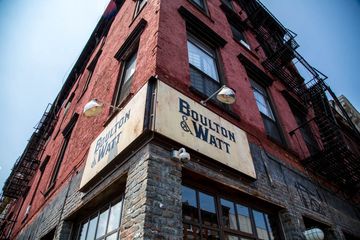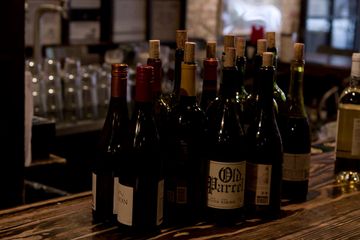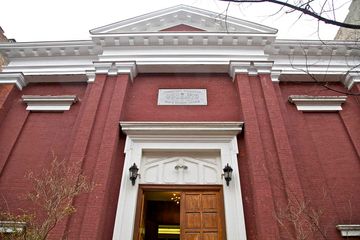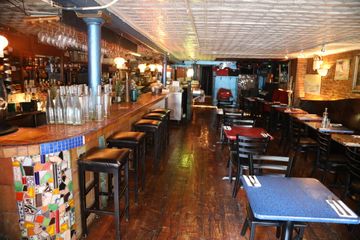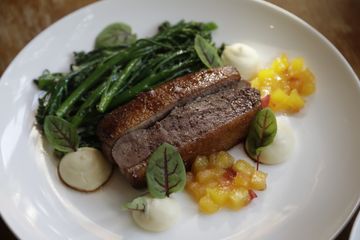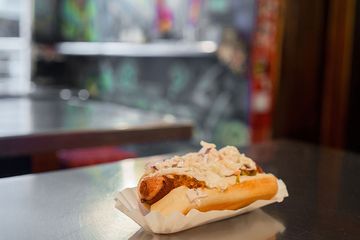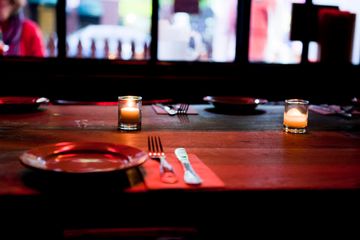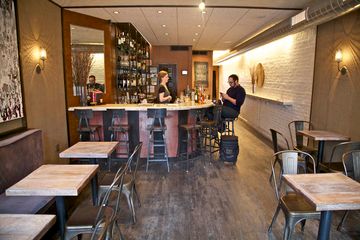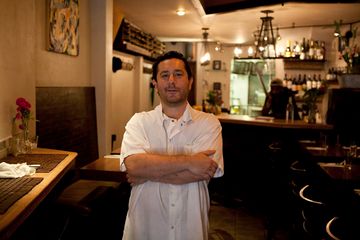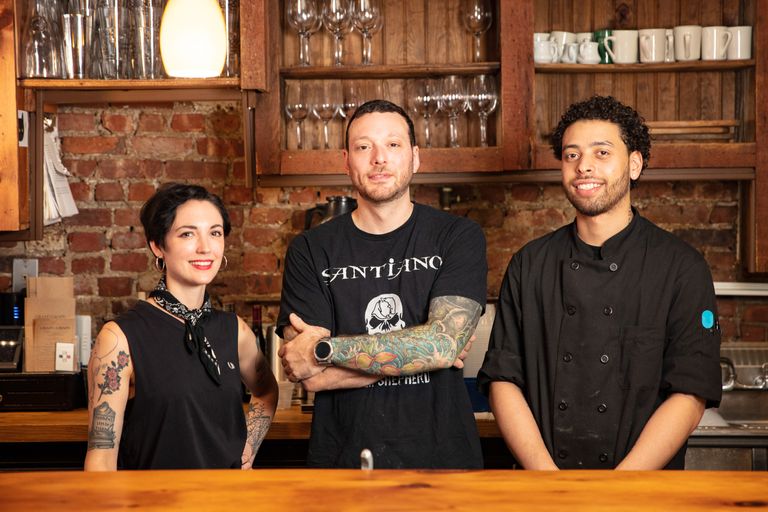
Anyone who has lived in New York long enough has likely experienced the nostalgia-infused anxiety of shuttered businesses in their area. Julia Howe, general manager of Grape and Grain, sympathizes: “When your favorite restaurant or your favorite bar or venue or whatever gets bought out… You’re like, alright, well, there goes the neighborhood. What’s coming next?"
Therefore, in May 2018 when TJ Provenzano, co-founder of neighboring sushi restaurant Mayanoki, took over ownership of Grape and Grain - which had been established twelve years prior in 2006 - he decided to use the same name and neighborhood feel to keep at bay the community-crushing experience of serial shutdowns and never-ending newness. Advertising an embellishment of olden days, Grape and Grain designates itself “An East Village staple with a renewed focus.”
Unofficially, Provenzano gives a different description of Grape and Grain. “[We are] a punk rock wine bar,” he declared with pride. Grape and Grain’s punk-rockness is uniquely tied to its Americanness. Only wines grown, crushed, fermented, pressed, tanked, barreled, filtered, bottled, and aged in the US meet the bar at Grape and Grain. A consequence of its local exclusivity are unconventional flavors like orange wine that have become some of their most sought-after products. “In America, we can do whatever we want. We’re not bound by that same kind of rigid boundaries [as in Europe],” Provenzano explained. “We are free to experiment, so we consider Americans kind of the punk rockers of wine-making.”
Punk rock, Provenzano notes, is also very characteristic of the old East Village. Hence, while punk rock wines are a relatively new addition to Grape and Grain – they have only been served since 2018 – the wine selection references the community history that Grape and Grain strives to hold onto.
Grape and Grain’s local wines are a clear example of the careful balance that the restaurant strikes between preserving the past and improving the present. Another expression of this balance comes across in Grape and Grain’s food.
Originally, Grape and Grain was more bar than restaurant, but as Provenzano and his team adopted Grape and Grain, they listened closely to community feedback to determine how best to adapt the space to the neighborhood’s needs. One of the most frequent requests called for more food options. In response, Julia, who is also one of Grape and Grain’s bartenders, shares her space behind the counter with Dave, one of the chefs at the time of writing. Every day from scratch, Dave dishes up duck breasts and Belgian waffles and pan-roasted chicken and handmade pastas on the five induction burners in the back of the bar.
Although Dave lives in Brooklyn, he grew up in the East Village and therefore has a respect for what he remembers of the way things were. Nevertheless, Dave’s cooking is not restricted by what is already on the menu. As with the rest of Grape and Grain, Dave introduces the new to the old by flavoring the past with a sprinkling of himself.
“A fair amount of items on the menu… customers know and enjoy… but also, TJ expressed that he wants the chef to feel like this is as much my doing as everyone else,” Dave says. “That entails me getting creative… us getting creative and feeling like our fingerprints are all over everything we do here.”
Highlighting the other end of their past-present, old-new equation, Provenzano mentions that the new ownership “didn’t wanna give the impression that these hipsters from Brooklyn were comin’ in and runnin’ over their neighborhood, but we wanted to listen to them, and we wanted to give them the experience that they wanted.”
Even the music accommodates to the mood of the customers rather than being a tool to construct a particular environment or vibe.
“We’re like ‘hey man, everyone in here seems to be really feeding off each other’s energy. Let’s play this,’” Julia described. “Or like ‘hey, it’s a rainy, quiet Tuesday night. Let’s put on some jazz and just pour some red wine and just chill out.’”
In general, Grape and Grain maintains a mellow atmosphere.
“A lot of people come here, and they’re looking for a place to have a nice, quiet evening without feeling trampled on or pressured in any way,” Julia remarked.
Part of the quiet character of Grape and Grain comes from its incredibly local clientele. Howe estimates that about seventy percent of the customers are from between Avenues B and D between 1st and 8th Streets. The majority live just across 6th Street or upstairs. Many customers stop by every day to grab a glass of wine on their way back home.
Because of its provincial spirit, Howe knows the names of almost everyone who comes through. She loves to see when neighbors, previously unknown to each other, meet for the first time at Grape and Grain. Such intimacy, Julia believes, can only be found on a side street.
“You get to see relationships form, and I think that would be less likely to happen if we were on a busy avenue,” Julia reflected. “It’s cool to see so many people who probably wouldn’t connect outside forming relationships. You get to be a part of that, and it’s so great.”
Grape and Grain aspires to maintain the aspect and ambience of what it sees as an East Village institution, and yet, the neighborhood around it continues to change. Many of the regulars are in their early-to-mid twenties and new to the neighborhood. Julia sees their presence at Grape and Grain as an opportunity to share stories about the East Village that she grew up in, even when that means being seen as the creepy old woman behind the bar who starts all of her sentences with “‘when I was your age.’”
Julia admitted that being on 6th Street, just a little too uptown of the J train and just a little too downtown of the L train, it can be tough to attract customers from other parts of the city. However, Provenzano maintains “we are a side street business, and we’re proud of that. We wanna be the place that is a little underground.”
Overlooked but under our noses, Grape and Grain is delicious and different and local, just like its wines.
